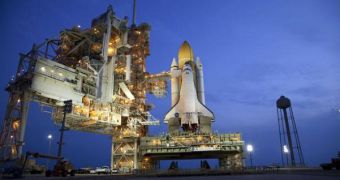The cargo that the space shuttle Atlantis will be carrying to low-Earth orbit (LEO) during its last flight has now been delivered to the Launch Pad 39A facility. This is where the orbiter is undergoing final preparations ahead of its planned July 8 takeoff.
The cargo pod containing everything Atlantis will soar to the skies with was delivered on Thursday, June 16, and the event marked the last time such a pod will ever be transported at the Kennedy Space Center (KSC), in Florida.
Engineers are currently getting ready to install the pod into the shuttle, while at the same time continuing to conduct all the necessary tests and assessments to ensure that the spacecraft is ready for its 12-day mission.
STS-135 will be the last flight of the American Space Shuttle Program (SSP). During the mission, Atlantis will be piloted by a group of four veteran astronauts, and will be heading towards the International Space Station (ISS).
NASA announced some time ago that there are no extravehicular activities (EVA) scheduled to be conducted by the shuttle crew. From now on, ISS passengers, starting with Expedition 28 astronauts, will be conducting all maintenance spacewalks on the outpost, Space reports.
Atlantis will carry its 8,000 pounds (nearly 4,000 kilograms) of cargo inside the Multipurpose Logistics Module (MPLM) Rafaello. In addition to this payload, the shuttle will also include an experiments platform in its cargo bay.
The orbiter will also carry a robotic experiment that could very easily change the way satellites are designed and built. The Robotic Refueling Mission (RRM) experiment is a technology demonstrator that is designed to prove that it's possible to refuel satellites in orbit.
This gas station is designed in such a way that it is backwards-compatible with spacecraft that were launched before it was created. What it does is it transfers fuel from its storage tanks to satellites that dock to it for refueling.
The spacecraft can then move away, and resume their positions in orbit around Earth. Future generations of satellite may in fact be designed specifically to support orbital refueling. This would contribute to extending their operating life, and reducing costs associated with space launches.
It is also conceivable that such stations could contain the fuel spacecraft need in order to travel to near-Earth objects (NEO), asteroids, the Moon, Mars, or other locations in the solar system. The orbital fuel storage facilities may serve both manned and unmanned vehicles.

 14 DAY TRIAL //
14 DAY TRIAL //